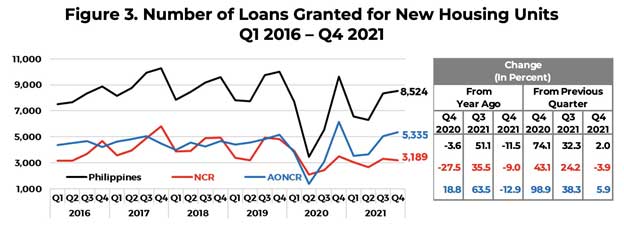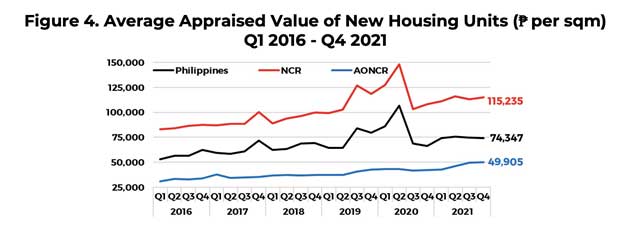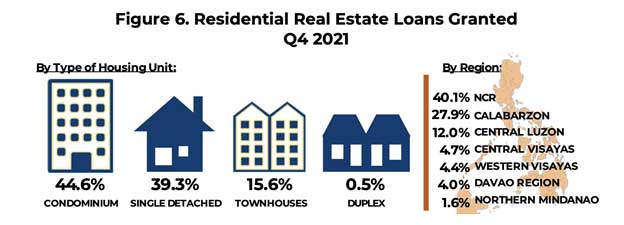The residential real estate prices of various types of new housing units in the Philippines continued to rise in Q4 2021 due to the sustained demand for residential property, particularly for townhouses and condominium units. The Residential Real Estate Price Index (RREPI) sustained its growth trend in Q4 2021, rising by 4.9 percent and 1.1 percent compared with year-ago and quarter-ago levels. This is consistent with the outcome of the Q4 2021 Consumer Expectations Survey (CES), which showed a higher percentage of consumers preferring to buy real estate property during the last quarter of 2021 (Figure 1).[1]

By area, residential property prices in the National Capital Region (NCR) and Areas Outside the NCR (AONCR) rise YoY, but decline QoQ in the NCR
Residential property prices in the NCR increased by 5.0 percent year-on-year (YoY) albeit lower than 11.4 percent in Q3 2021. Similarly, property prices in the AONCR went up by 5.1 percent YoY. Prices in both areas were driven mainly by the rise in the prices of condominium units and townhouses, which more than offset the decline in the prices of duplex housing units and single-detached/attached houses.
On a QoQ basis, residential property prices rose in the AONCR (by 2.6%), following the national trend, but declined in the NCR (by 1.2%) (Figure 1).
By type of housing units, the rise in prices of townhouses and condominium units drive YoY growth in property prices
The 4.9 percent YoY upturn in the nationwide RREPI in Q4 2021 was primarily driven by the rise in prices of townhouses and condominium units, increasing by 22.6 percent and 10.4 percent, respectively. The YoY growth in their prices, however, were slower compared with that posted in Q3 2021. In the case of condominium units, the upward trend in prices was mainly attributed by the units in the AONCR. By contrast, prices of duplex housing units and single-detached/attached houses contracted by 10.2 percent and 1.1 percent, respectively (Figure 2).

Meanwhile, the QoQ growth of 1.1 percent in the RREPI was attributed to the higher prices of duplex housing units, single-detached/attached houses, and condominium units (Figure 2).
Nationwide residential real estate loans for new housing units decrease YoY, but increase QoQ
In Q4 2021, the number of residential real estate loans (RRELs) granted for all types of new housing units in the Philippines contracted by 11.5 percent YoY, but expanded by 2 percent QoQ. The same pattern was observed in the AONCR. However, for the NCR, the number of loans granted declined from year- and quarter-ago levels (Figure 3).

The average appraised value of new housing units in the country stood at Php74,347 per square meter (sqm).[2] The average appraised value per sqm was higher in the NCR (at Php 115,235) than both the national average and AONCR average (at Php49,905) (Figure 4).

The weight of each type of housing unit in the RREPI is determined by dividing the total floor area (in sqm) of a specific type of housing unit over the total floor area of all housing types. In Q4 2021, single-detached/attached houses in the RREPI continued to constitute the largest weight at 51 percent. Meanwhile, condominium units, townhouses, and duplex housing units accounted for 27.5 percent, 21 percent, and 0.6 percent, respectively (Figure 5).

Profile of residential real estate loans in Q4 2021
In Q4 2021, almost a third (73.5%) of residential real estate loans (RRELs) were used to purchase of new housing units.[3] Meanwhile, by type of housing unit, most of the residential property loans were used for the acquisition of condominium units (44.6 percent), followed by single-detached/attached houses (39.3 percent) and townhouses (15.6 percent) as seen in Figure 6.

Most of the RRELs granted in the NCR were for the purchase of condominium units, while RRELs granted in the AONCR were for the purchase of single-detached/attached houses. By region, 40.1 percent of the total number of RRELs granted were from the NCR, while the rest were distributed in the AONCR―CALABARZON (27.9 percent), Central Luzon (12 percent), Central Visayas (4.7 percent), Western Visayas (4.4 percent), Davao Region (4 percent), and Northern Mindanao (1.6 percent). NCR and the said six regions combined accounted for 94.7 percent of total housing loans granted by banks (Figure 6).
About the report
The RREPI is a measure of the average change in the prices of various types of housing units, i.e., single-detached/attached houses, duplex housing units, townhouses, and condominium units, based on banks’ data on actual mortgage loans granted to acquire new housing units only. It is a chain-linked index, which is computed using the average appraised value per square meter, weighted by the share of floor area of each type of housing unit to the total floor area of all housing units. The RREPI is used as an indicator for assessing the real estate and credit market conditions in the country. The BSP has been releasing the report since Q1 2016.
Data for the RREPI are obtained through BSP Circular No. 892 dated 16 November 2015, which requires all universal/ commercial banks (UBs/KBs) and thrift banks (TBs) in the Philippines to submit to the BSP a quarterly report on all RRELs granted.
[1] The Q4 2021 CES results showed that 16.8 percent of Filipino households considered Q4 2021 as a favorable time to buy a house and lot. This was an increase from the 12.7 percent registered in Q4 2020.
[2] The average appraised value per sqm is computed as the simple average of all reported appraised values of properties based on RRELs granted for the reference period. As such, the national average will be affected by the number of large or low values in an area. Case in point, in Q4 2021, RREL transactions in the AONCR were almost double in number than those in the NCR. However, these AONCR transactions had values that were about half of those in the NCR.
[3] Among the residential housing properties purchased using RRELs in Q4 2021, 26.1 percent were pre-owned, while 0.4 percent were foreclosed properties.






















